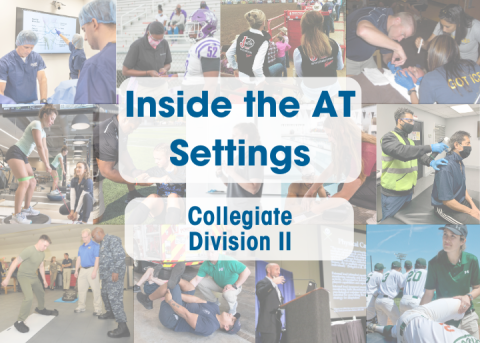
Introduced in the April NATA News, this NATA Now article series provides insight into the different athletic training settings as well as information athletic training students and interested ATs need to know. The series also provides tips from members on how to succeed in each setting.
Danielle Lodanosky, MS, LAT, PES, athletic trainer at Pennsylvania Western University at Edinboro, has been in the collegiate setting for 10 years. As a graduate assistant, Lodanosky explored different collegiate divisions and said she found her professional home in Division II.
“I knew my heart was in Division II,” she said. “The athletes at Division II are here for the love of the game, and because of their skill level, they still receive some scholarship monies. They are grateful for the opportunity and want to make the most of it.”
Lodanosky shares what ATs need to know about the collegiate Division II setting.
Typical Makeup of Your Population
We have 19 NCAA sponsored sports and approximately 400 student athletes. Our athlete population is diverse in nationality and socioeconomic background.
Non-AT-Related Skills/Education/Certification Required or Helpful for Your Setting
I am a certified National Academy of Sports Medicine Performance Enhancement Specialist and I utilize that daily in my rehab planning as we do all our own rehabs. Students aren’t referred out to physical therapy, if it’s during the traditional academic year. I’m also an instructor for the American Red Cross in CPR and AED. This aids the Exercise Science and Education departments on campus.
Common Injuries Observed or Encountered in Your Setting
In the past five years, we’ve had an influx of lower-body injuries – in particular, ACL tears – and this past fall season, we’ve had no less than four athletes need shoulder surgery. I don’t believe we have any abnormal injuries from anyone else. Although, I do feel there was an increase in injury following the COVID-19 shutdown because of a lack of training during that time. We’re getting further away from there, so I don’t believe that any of our injuries now are because of that in particular.
Traits of a Successful AT in Your Setting
Our student athletes, I have found, just want to know that you care. If you can show them you care about them as a whole person and connect with them outside of their athletic ability, they are going to trust you, listen to you and respect you.
Misconceptions About Your Setting and/or Patient Population
The main misconception is that all our student athletes are on scholarship. Most of our athletes don’t get much, if any, money to participate. It’s also the misconception that our students aren’t as skilled because they aren’t at the Division I level and, ultimately, while they may not be as skilled in every way, they have a lot of skill in different ways.





